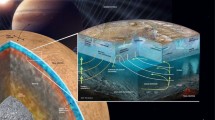Abstract
A geodynamic model of the modern Earth is constructed based on the SMEAN 2 global seismic tomography model with an emphasis on the Arctic region. For a spherical Earth model, a solution of the Stokes equation for a viscous fluid was obtained based on seismic tomography data using the CitcomS code. The resulting distributions of temperature anomalies and velocity fields of mantle flows explain the main features of the modern geodynamics of the Arctic region. The temperature difference in the subcrustal mantle between the relatively “cold” western Arctic shelf (Barents and Kara seas) and the “warmer” eastern Arctic shelf (from the Laptev Sea to the Bering Strait) reaches 100 degrees, which correlates with the observed intense methane emission from the shallow shelf of the Eastern Arctic caused by permafrost degradation and destruction of gas hydrates against the background of elevated environmental temperatures. The greenhouse effect of methane in the atmosphere, in turn, contributes to climate warming in the Arctic. The region of Iceland and eastern part of Greenland, under the influence of the mantle upwelling, is characterized by a hot subcrustal mantle and increased heat flow at the surface, causing instability and melting of the Greenland ice sheet from below.




Similar content being viewed by others
REFERENCES
L. I. Lobkovsky, E. V. Shipilov, and M. V. Kononov, Izv., Phys. Solid Earth 49, 767–785 (2013).
L. I. Lobkovsky, Russ. Geol. Geophys. 57 (3), 371–386 (2016).
N. P. Laverov, L. I. Lobkovsky, M. V. Kononov, N. L. Dobretsov, V. A. Vernikovsky, S. D. Sokolov, and E. V. Shipilov, Geotectonics 47, 1–30 (2013).
L. I. Lobkovsky, Yu. V. Gabsatarov, D. A. Alekseev, I. S. Vladimirova, M. M. Ramazanov, and V. D. Kotelkin, Geodynam. Tectonophys. 13 (5), 0675 (2022).
L. Lobkovsky, Yu. V. Gabsatarov, D. A. Alekseev, I. S. Vladimirova, M. Ramazanov, and V. D. Kotelkin, Russ. J. Earth Sci. 22 (1), 1–15 (2022).
T. W. Becker and L. Boschi, Geochem. Geophys. Geosyst. 3 (1) (2002). https://doi.org/10.1029/2001GC000168
C. K. Lee, S. C. Han, and B. Steinberger, Phys. Earth Planet. Inter. 184 (1–2), 51–62 (2011).
C. Megnin and B. Romanowicz, Geophys. J. Int. 143, 709–728 (2000).
G. Schubert, D. L. Turcotte, and P. Olson, Mantle Convection in the Earth and Planets (Cambridge Univ. Press, New York, 2001).
A. M. Bobrov and A. A. Baranov, Pure Appl. Geophys. 176 (8), 3545–3565 (2019).
T. J. R. Hughes, The Finite Element Method: Linear Static and Dynamic Finite Element Analysis (Prentice-Hall, Englewood Cliffs, NJ, 1987).
A. Ramage and A. J. Wathen, Int. J. Num. Methods Fluids 19, 67–83 (1994).
Y. Fei, J. V. Orman, J. Li, W. van Westrenen, C. Sanloup, W. Minarik, K. Hirose, T. Komabayashi, M. Walter, and K. Funakoshi, J. Geophys. Res. 109, B02305 (2004).
S. Zhong, M. T. Zuber, L. N. Moresi, and M. Gurnis, J. Geophys. Res.: Solid Earth 105 (B5), 11063–11082 (2000).
A. A. Baranov, L. I. Lobkovskii, and A. M. Bobrov, Dokl. Earth Sci. 512 (1), 854–859 (2023).
A. Chuvaev, A. Baranov, and A. Bobrov, Comput. Technol. 25 (2), 103–118 (2020).
L. I. Lobkovsky and V. D. Kotelkin, Russ. J. Earth Sci. 6 (1), 49–58 (2004).
N. Shakhova, I. Semiletov, A. Salyuk, V. Joussupov, D. Kosmach, and O. Gustaffson, Science 327, 1246–1250 (2010).
I. M. Artemieva, Earth-Sci. Rev 188, 469–481 (2019).
L. Lobkovsky, A. Baranov, I. Garagash, M. Ramazanov, I. Vladimirova, Yu. Gabsatarov, D. Alekseev, and I. Semiletov, Geoscience 13, 171 (2023).
ACKNOWLEDGMENTS
We thank the Reviewers for constructive comments which helped to improve the manuscript.
Funding
The work was carried out partly within the framework of the state assignment of the P. P. Shirshov Institute of Oceanology of the Russian Academy of Sciences no. FMWE-2021-0004, partly within the framework of the state assignment of the Institute of Earthquake Prediction Theory and Mathematical Geophysics of the Russian Academy of Sciences no. AAAA-A19-119011490131-3 and partly within the framework of the state assignment of Schmidt Institute of Physics of the Earth, Russian Academy of Sciences no. FMWU-2022-0002.
Author information
Authors and Affiliations
Corresponding author
Ethics declarations
The authors of this work declare that they have no conflicts of interest.
Additional information
Publisher’s Note.
Pleiades Publishing remains neutral with regard to jurisdictional claims in published maps and institutional affiliations.
Rights and permissions
About this article
Cite this article
Lobkovsky, L.I., Baranov, A.A., Bobrov, A.M. et al. Global Geodynamic Model of the Earth and Its Application to the Arctic Region. Dokl. Earth Sc. (2024). https://doi.org/10.1134/S1028334X23603000
Received:
Revised:
Accepted:
Published:
DOI: https://doi.org/10.1134/S1028334X23603000




